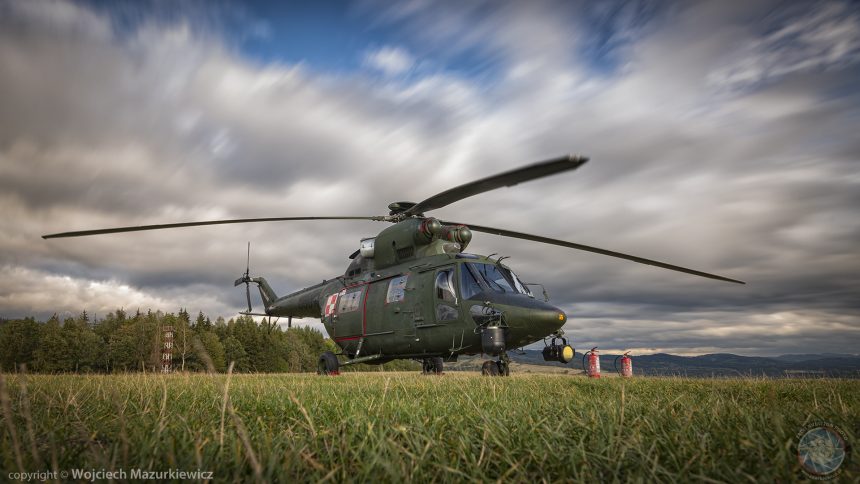We take a closer look at the Poland’s largest SAR Exercise organized in 2020.
RENEGADE/SAREX-20 took place between Oct. 6 and 9, 2020, and was organized by the Operational Command of the Armed Forces (DO RSZ).
The primary objective of the exercise was to verify the ability of the military to cooperate with non-military entities in crisis scenarios, to respond to crises. Particular attention was paid to the events emerging within the contexts of air defense, maritime and air rescue systems. The exercise allowed for coordination of the command and control elements of the individual services and entities, be it on the central, or local levels. The ARCC’s (Aeronautical Rescue Coordination Centre) capacity to launch, control and coordinate SAR ops was verified, throughout the course of the exercise, in the specific area of responsibility (FIR Warsaw). The relevant organs involved in the ASAR (Aeronautical SAR) plan also participated in the events.
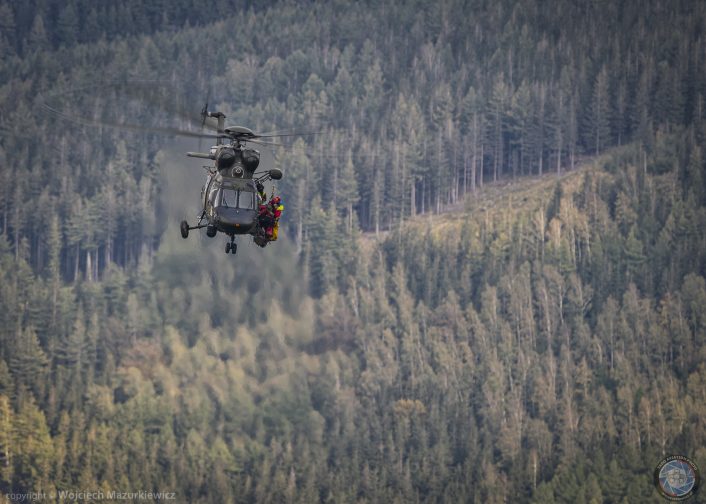
Exercise Setting
Interestingly, the exercise took place in numerous locations, all around Poland – from the Gdansk and Pomeranian regions, through Karkonosze mountains, Parczew forested area and in the Western Pomeranian, Pomeranian, Podlachian, Lubelskie, and lower Silesian Voivodeships. The operation involved all of the entities, services and organizations responsible for safety and rescue systems. On the military side, these included the Armed Forces (DO RSZ with its subordinated centres and organs), some elements of the General Command of the Armed Forces, the Military Police, the Polish Territorial Defense component. The civil entities included the Polish Air Navigation Services Agency, Police, Border Guard, State Fire Service, Volunteer Fire Service, Maritime SAR Service, HEMS, Polish Red Cross, Mountain Volunteer Search and Rescue [Polish: Górskie Ochotnicze Pogotowie Ratunkowe (GOPR)], Lublin Airport, some of the medical rescue elements and the Governmental Center for Security and Voivodeship Crisis Response Centres.
NCOs of the Air Force Academy and Military University of the Land Forces and students of the Karkonosze Higher Education School were acting as the simulated survivors. The exercise was quite significant since it involved 1,000 persons, 11 aircraft and 6 vessels – coming from the Polish Navy and the civil entities.
Exercise Scenario
Altogether, six episodes were executed within the framework of the exercise, including two that focused on the Polish air defense system. The exercise is usually divided into two sections – the so-called RENEGADE portion, and four focused on ASAR/SAR taskings – referred to as SAREX. The RENEGADE portion was focused on counter-terrorism operations. Two civilian aircraft, classified as RENEGADE (i.e. as aircraft that suffered from a hijacking), were intercepted by the Polish QRA assets. Then they were brought down to the airfields designated as ones to be used in these scenarios. This portion of the exercise also involved the ground personnel, in a hostage-situation scenario (negotiation and hostage rescue). One of the episodes also involved activities in which the civilians were warned about the developments happening in the area of airborne threats.
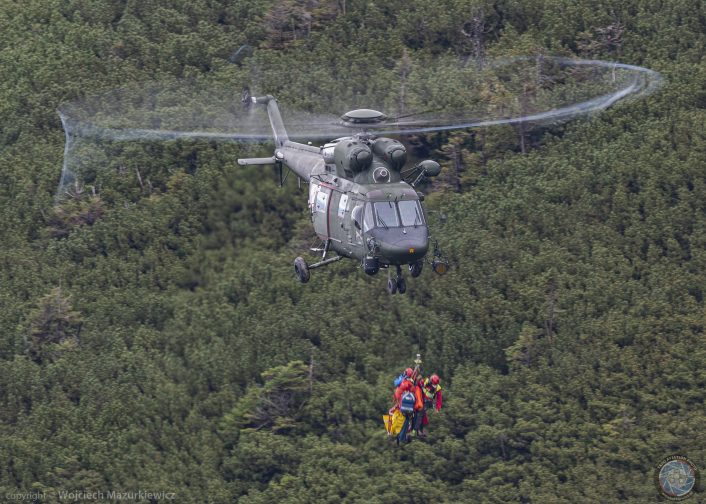
Maritime SAR Operation
Another two scenarios concerned the maritime SAR operations, with two training SAR missions accomplished. One episode concerned a sunken vessel, and the scenario assumed that persons would be rescued from the so-called air trap underwater. The second operation was a SAR mission involving a search for a person overboard a ferry. After the victims were rescued, Darłowo and Gdynia Maritime SAR units (with helicopters) dealt with transporting them to the hospitals. These operations also involved assets belonging to the Polish Navy.
Mountain Rescue Operation
During the mountain portion of the exercise, the Air Force’s ASAR team using a W-3WA SAR helicopter hailing from the 1st SAR Group based at the Świdwin Air Base, remaining on ad hoc duty near Jelenia Góra (Szybowcowa Góra, German name: Schieferberg), jointly with the GOPR rescue team, executed a SAR operation that was initiated after a simulated crash of an aircraft carrying 40 passengers. The event took part in the area of the Śnieżka mountain and the Kocioł Łomniczki cirque in the Karkonosze National Park, and in the Góra Wołowa area. The rescue operations here also involved the S-70i Black Hawk helicopter belonging to the Polish Police, with a Special Mountain Rescue Team of the State Fire Service’s Unit 7 from Warsaw. The mountain portion of the exercise made it possible to verify the skills of the pilots in mountain flying. Coordination of the Polish crisis response system was also verified here. Additional training, before the final verification, had taken place before the actual exercise – between August and September. Three training events had been organized in total, before the RENEGADE/SAREX-20 event.
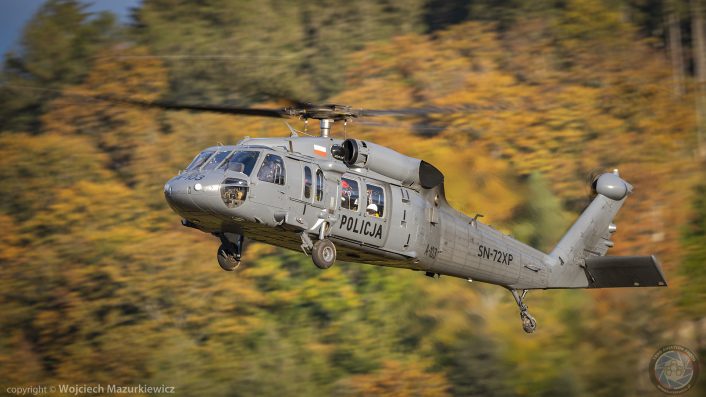
15 students of the Karkonosze Higher Education School were sent to the area of rescue operations to simulate the survivors, along with 25 NCOs of the Military University of the Land Forces, along with policemen and two representatives of the Karkonosze National Park and ARCC (Air Rescue Coordination Centre). The episode was launched around 10.55 LMT. The relevant COSPAS-SARSAT system message was received at 11.03 LMT, suggesting that a rescue signal has been sent in the Góra Wołowa area, by a civilian airliner flying from Prague to Warsaw. The message was actually sent – by one of the team members designated to do so. The ARCC coordinator immediately launched the rescue operation, informing the GOPR mountain rescue service and the ASAR crew about the emerging circumstances. After the authorization was issued by the overlooking organ, the military ARSC (Aeronautical Rescue Sub-Centre) in Warsaw, the ASAR crew immediately took off to execute the SAR mission. One of the ARSC Warsaw officers acted in a liaison role at the Karkonosze GOPR group Coordination Center.
The Lower Silesian Voivodeship Crisis Response Center (Wojewódzkie Centrum Zarządzania Kryzysowego – WCZK) also received the information on the crash of a passenger airliner with 40 persons onboard, from the ARCC. This organ was responsible for tasking the Kowary Volunteer Fire Service and Jelenia Góra State Fire Service units, as well as the Ambulance service in Kowary and Police units. The aforesaid services would secure the crash site and the area where the rescue services would gather, in Kowary. As the Fire Service teams were preparing the location where the victims would be transported, the coordinator of the rescue operation got in touch with the C2 station and the ARCC coordinator. The first of the rescuers on-site was tasked with coordinating the medical activities.
Due to the high number of survivors, the SAR operation also involved the S-70i Black Hawk helicopter (Polish Police’s aircraft carrying the State Fire Service’s Mountain Rescue Unit rescuers), and Wrocław Medical Rescue Group of the Polish Red Cross. The S-70i has reached the area after 1 hour 45 minutes and got involved in the operation, contacting the Air Coordinator (ACO). Around 1315 LMT the duty officer of the Karkonosze GOPR Group received a report that five victims were found in the Kocioł Łomniczki/Rynna Śmierci area. This has initiated the part II of this portion of the exercise. Immediately, the W-3 WA SAR helicopter was redirected to the area by the ARCC and the GOPR C2 centre. The rescuers used the fast rope to get down to the ground and prioritize the rescue that began right afterwards. The survivors were transported to Kowary, where the services-involved were gathered.
As the SAR operation was running late, especially in the Góra Wołowa region, the rescuers of the GOPR/GRM PCK elements on-site segregated the survivors and were prioritizing the rescue. This made it possible to establish a proper rescue sequence. Then, the hospital rescue wards (SOR) were contacted, via the Legnica Medical Coordination Center responsible for the area, and information was gathered whether they could provide help to the patients and whether any extra ground rescue units could help in the rescue process. One of the wounded persons was evacuated directly to the hospital rescue ward by the S-70i Black Hawk Helicopter (Medical Center of Jeleniogórska Valley). Furthermore, a landing site organized at the Mountain Training Centre of the Military University of the Land Forces in Szklarska Poręba was used by the W-3WA SAR helicopter – there, the GOPR rescuers boarded the aircraft.
What’s interesting, an actual accident also took place during the Karkonosze Mountains episode of the exercise. The rescue team involved in training helped a tourist who was involved in a real event requiring the deployment of rescue assets in the area.
CSAR Mission
The last episode of the exercise was focused on a rescue operation in the Parczew forests, where a SAR operation was conducted following a simulated MiG-29 crash. The area of rescue was covered with dense forest and lakes and swamps. According to the scenario, two Fulcrum pilots were forced to eject. The rescue operation involved an ASAR team flying the Mi-17 helicopter hailing from the Leżnica Wielka 1st Aviation Squadron. Additional support was provided by the EC135H helicopter of the Border Guard. On the ground, rescue teams of the Territorial Defense Forces and Polish Red Cross, as well as of the Polish Police were all involved. Furthermore, Polish Military Police, State Fire Service and Volunteer Fire Service units were also engaged here. Finally, Warszawa K-9 unit and Lublin 4 divers group also took part in the activities.
The rescue operations were coordinated by the ARCC. Three components were involved here. PANSA (Polish Air Navigation Services Agency) was the primary one. Additionally, control centres were established at two military sub-centres designated by the Air Operations Centre – Air Component Command, and Maritime Operations Centre – Naval Component Command. In case of the RENEGADE episodes, the air defense command unit coordinated the activities.
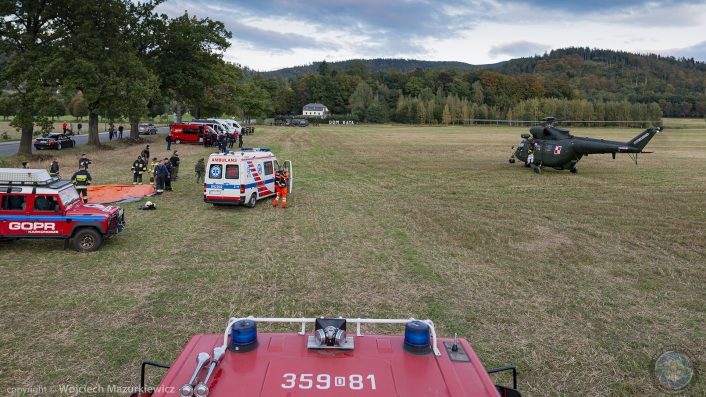
Conclusions
Summing the exercise up, the objectives were accomplished. Some areas of improvement have also been indicated. The above refers primarily to the domain of communications compatibility between the services participating in the activities. Coordination of the ASAR elements and the non-military units is a valuable benefit gained here. It constitutes an element that would need to be given more focus in the future. This would, ultimately, make it possible to eliminate the potential weak points in the ASAR Plan.
Written with ARCC Deputy Commander, Head of the CAI/RASP Management Branch – Air Defense Branch of the Operational Command of the Armed Forces, Col. Marcin Szafraniec.

